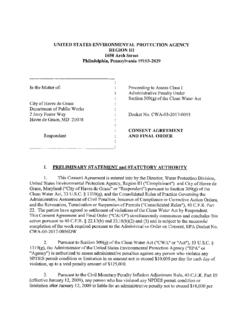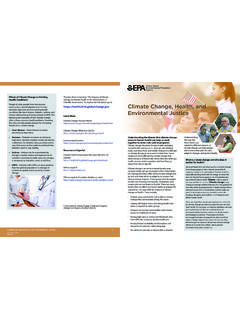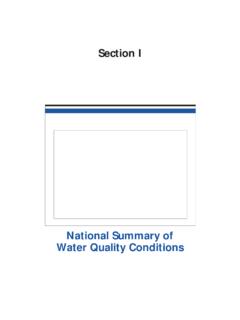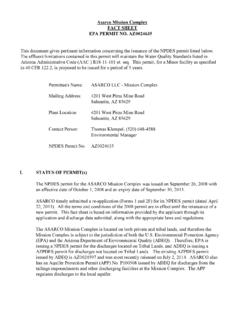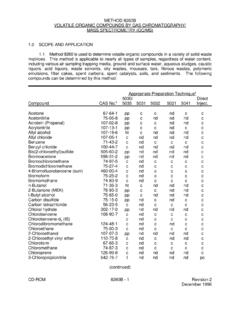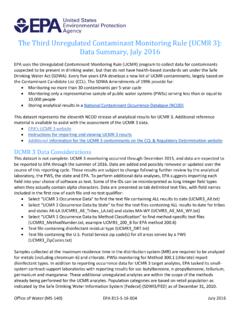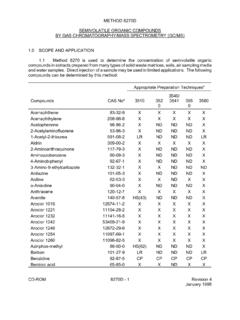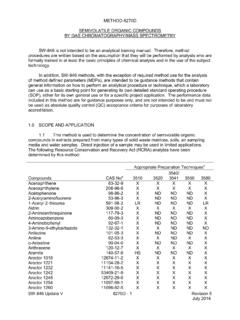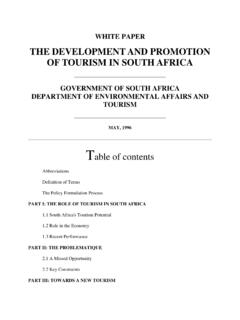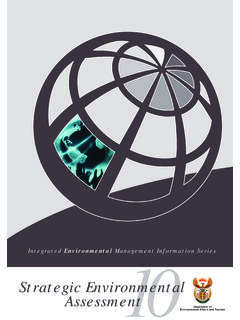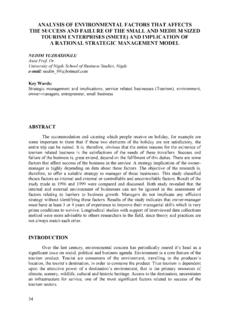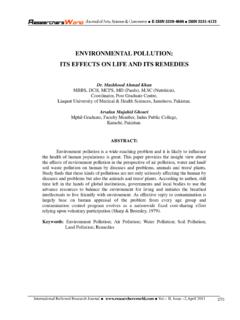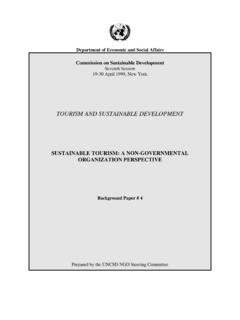Transcription of What Climate Change Means for Hawaii - US EPA
1 August 2016. EPA 430-F-16-013. what Climate Change Means for Hawaii Hawaii 's Climate is changing. In the last century, air Ocean Warming and Acidif ication temperatures have increased between one-half and one The waters around Hawaii are warming, which is harming degree (F). Warming in the oceans around Hawaii has Hawaii 's coral reefs and marine ecosystems. The El Ni o- damaged coral reefs, and, in recent decades, increased Southern Oscillation ( El Ni o ) and other natural cycles cause ocean acidity has threatened reefs and other marine ocean temperatures in the Pacific to fluctuate from year to year ecosystems. Average precipitation decreased in the last and from decade to decade. Even after accounting for these century, reducing freshwater availability on some islands and natural patterns, the waters around Hawaii have been warming affecting delicate land-based ecosystems, often harming since the 1950s, with temperatures rising by several degrees native species. In the last 50 years, sea level has risen along from the ocean surface down to at least 600 feet.
2 Rising water Hawaii 's shores, increasing erosion and threatening coastal temperatures can harm the algae that live inside corals. Because communities and infrastructure. algae provide food for the coral, a loss of algae weakens corals Climate is changing because the earth is warming. People and can eventually kill them. This process is commonly known as have increased the amount of carbon dioxide in the air by "coral bleaching," because the loss of the algae also causes the 40 percent since the late 1700s. Other heat-trapping green- corals to turn white. Mass bleaching events are becoming more house gases are also increasing. These gases have warmed common, with documented cases in the north-western Hawaiian the surface and lower atmosphere of our planet about one Islands in 1996 and 2002. Water temperature spikes in Hawaii degree during the last 50 years. Evaporation increases as have also been linked to coral disease outbreaks. the atmosphere warms, which increases humidity, average rainfall, and the frequency of heavy rainstorms in many places but contributes to drought in others.
3 Greenhouse gases are also changing the world's oceans and ice cover. Carbon dioxide reacts with water to form carbonic acid, so the oceans are becoming more acidic. The surface of the ocean has warmed about one degree during the last 80 years. Warming is causing snow to melt earlier in spring, and mountain glaciers are retreating. Even the great ice sheets on Greenland and Antarctica are shrinking. Thus the sea is rising at an increasing rate. Bleached corals in Kaneohe Bay, Oahu, in the fall of 2014. Credit: XL. 80. Catlin Seaview Survey 79. Increasing ocean acidity can also damage corals, as well as Average Temperature ( F). 78. 77 shellfish and other organisms that depend on minerals in the 76 water to build their skeletons and shells. The acidity of the 75 Pacific Ocean has increased by about 25 percent in the past 74 three centuries, and it is likely to increase another 40 to 50. 73 percent by 2100. 72. Warming and acidification could result in widespread damage to 71 Honululu Kahului Lihue Hilo the entire marine ecosystem in the waters off Hawaii .
4 Hawaii 's 70. 1950 1960 1970 1980 1990 2000 2010 2020. isolation in the Central Pacific makes it home to a wide range of Year fish species not found anywhere else in the world. Many of these Average annual temperatures have increased across Hawaii since fish rely on healthy coral reefs for habitat, and even with substan- 1950. Source: NOAA tial cuts to greenhouse gas emissions, up to 40 percent of coral to expand their ranges into higher elevations, infecting native birds with diseases like avian malaria. Shoreline Loss Since 1960, sea level has risen between two and eight inches relative to Hawaii 's shoreline. Sea level rise can make Hawaii 's existing coastal hazards such as waves, hurricanes, tsunamis, and extreme tides even worse. Additionally, rising sea level has accelerated coastal erosion, which has resulted in wetland mi- Tourism infrastructure and nearshore coral reefs, both threatened by gration and cliff collapse. Chronic erosion has affected more than Climate Change , in Maui.
5 Credit: Hudson Slay, EPA Region 9. 70 percent of Kauai and Maui's beaches over the last century. Sea level rise and the associated coastal impacts due to in- reef fish could lose their habitats by 2100. Reefs also protect creased flooding, elevated ground water tables, storm surge, nearshore fish nurseries and feeding grounds. Damage to coral and erosion have the potential to harm an array of natural and reduced fish populations could negatively impact the and built environments in Hawaii . Dying coral reefs add to this state's economy, as these natural resources bring an estimated problem, as they leave the shoreline more vulnerable to erosion $385 million to Hawaii each year through tourism, direct and damage from waves. In the Northwestern Hawaiian Islands consumption, and commercial fisheries. Marine National Monument, sea level rise threatens native species, especially those that nest on beaches, such as green Water Availability sea turtles, Hawaiian monk seals, and the endangered Laysan Rainfall in Hawaii has been decreasing, but scientists do not finch.
6 Damage to coastal infrastructure may also hurt Hawaii 's know whether that trend will continue. El Ni o will probably economy, more than a quarter of which stems from tourism. continue to dominate precipitation patterns from year to year in Waik k Beach alone brings in $2 billion per year in visitor spend- the tropical Pacific. Climate Change -related increases in air ing. Furthermore, many of Hawaii 's native communities are in temperatures will lead to more evaporation and more moisture vulnerable coastal areas. Sea level rise and associated flooding in the air. As a result, the variability in El Ni o-related are expected to destroy land, coastal artifacts, and structures of precipitation is likely to increase, making rainfall predictions significant cultural value, and may force these communities to difficult. relocate. Although projections of future rainfall are uncertain, streams and rivers on the Hawaiian Islands have experienced a reduction in flow over the last century, resulting in less fresh water available for people and ecosystems.
7 Additionally, increased drought may threaten taro and breadfruit, which are important traditional food sources for Hawaii 's native peoples. Land Ecosystem Changes Ecosystems on land are also experiencing impacts from a warming Climate . Many native plant species could lose ground to invasive species better adapted to the changing Climate , or simply fail to thrive in altered habitats. For example, higher A seawall built in Ukumehame, Maui, to protect the shoreline and coastal infrastructure from erosion. Credit: Hudson Slay, EPA Region 9. temperatures and increased drought have caused dramatic declines among native plant species such as Haleakal silver- sword. Some native species display the ability to adapt to Climate Health and Vulnerable People Change , such as a few types of fire-adapted grasses that have Climate Change is likely to amplify some threats to health in Ha- shifted to higher altitudes in Hawaii Volcanoes National Park. waii. Certain people are especially vulnerable, including children, However, some insects such as mosquitoes have also been able the elderly, the sick, and the poor.
8 The sources of information about Climate and the impacts of Climate Change in this publication are: the national Climate assessments by the Global Change Research Program, synthesis and assessment products by the Climate Change Science Program, assessment reports by the Intergovernmental Panel on Climate Change , and EPA's Climate Change Indicators in the United States. Mention of a particular season, location, species, or any other aspect of an impact does not imply anything about the likelihood or importance of aspects that are not mentioned. For more information about Climate Change science, impacts, responses, and what you can do, visit EPA's Climate Change website at

